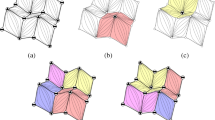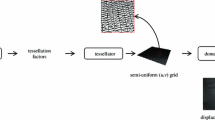Abstract
Hybrid digital terrain models represent an effective framework to combine and integrate terrain data with different topology and resolution. Cartographic digital terrain models typically are constituted by regular grid data and can be refined by adding locally TINs that represent morphologically complex terrain parts. Direct rendering of both data sets to visualize the digital terrain model would generate geometric discontinuities as the meshes are disconnected. In this paper we present a new meshing scheme for hybrid terrain representations. High quality models without discontinuities are generated as the different representations are softly joined through an adaptive tessellation procedure. Due to the complexity of the algorithms involved in the tessellation procedure, we propose a mixed strategy where part of the information is pre-computed and efficiently encoded. This way, for rendering the model, the tessellation information has to be decoded and only additional simple operations have to be performed.
Similar content being viewed by others
References
M. Amor, M. Bóo, and J.Döllner. “Hardware support for hybrid grid representation of terrains,” Technical Report, University of Santiago de Compostela, 2004. (www.ac.usc.es)
M. Amor, M. Bóo, J. Hirche, M. Doggett, and W. Strasser. “A meshing scheme for efficient hardware implementation of butterfly subdivision surfaces using displacement mapping,” IEEE Computer Graphics and Applications, Vol. 25(2):46–59, 2005.
K. Baumann, J. Döllner, and K. Hinrichs. “Integrated multiresolution geometry and texture models for terrain visualization,” in R. van Liere, and W. de Leeuw (Eds.), Proc. of Joint Eurographics—IEEE TVCG Symposium on Visualization 2000, pp. 157–166, Springer, Berlin Heidelberg New York, 2000.
M. Bóo, M. Amor, M. Doggett, J. Hirche, and W. Strasser. “Hardware support for adaptive subdivision surface rendering,” in Proc. of Siggraph/Eurographics Hardware Workshop, pp. 33–40, ACM, New York, 2001.
P. Cignoni, F. Ganovelli, E. Gobbetti, F. Marton, F. Ponchio, and R. Scopigno. “BDAM—Batched dynamic adaptive meshes for high performance terrain visualization,” in P. Brunet and D. Fellner (Eds.), Proc. of Eurographics 2003, Computer Graphics Forum, Vol. 22(3), pp. 505–514, Blackwell, Oxford, UK, 2003.
M. Doggett and J. Hirche. “Adaptive view dependent tessellation of displacement maps,” in Proc. of Siggraph/Eurographics Hardware Workshop, pp. 59–66, ACM, New York, 2000.
M. Kraus and T. Ertl. “Simplification of nonconvex tetrahedral meshes,” in Electronic Proc. of NSF/DoE Lake Tahoe Workshop for Scientific Visualization, 2000.
M. Kraus and T. Ertl. “Cell projection of cyclic meshes,” in T. Ertl, K. Joy, and A. Varshney (Eds.), Proc. of IEEE Visualization 2001, pp. 215–222, IEEE Computer Society, Los Alamitos, CA, 2001.
P. Lindstrom and V. Pascucci. “Visualization of large terrains made easy,” in T. Ertl, K. Joy, and A. Varshney (Eds.), Proc. of IEEE Visualization 2001, pp. 363–370. IEEE Computer Society, Los Alamitos, CA, 2001.
P. Lindstrom and V. Pascucci. “Terrain simplification simplified: A general framework for view-dependent out-of-core visualization,” IEEE Transactions on Visualization and Computer Graphics, Vol. 8(3):239–254, 2002.
F. Losasso and H. Hoppe. “Geometry clipmaps: Terrain rendering using nested regular grids,” in Proc. of ACM SIGGRAPH 2004, pp. 769–776, ACM, New York, 2004.
D. Luebke, M. Reddy, J. Cohen, A. Varshney, B. Watson, and R. Huebner. Level of Detail for 3D Graphics. Morgan Kaufmann, San Mateo, CA, 2002.
J. O’Rourke. Computational Geometry in C. 2nd edition, Cambrige University Press: Cambridge, MA, 1998.
R. Pajarola, M. Antonijuan, and R. Lario. “QuadTIN: Quadtree based triangulated irregular networks,” in R. J. Moorhead, M. Gross, and K. I. Joy (Eds.), Proc. of IEEE Visualization 2002, pp. 395–402, IEEE Computer Society, Los Alamitos, CA, 2002.
J. Schneider and R. Westermann. “GPU-Friendly high-quality terrain rendering,” Journal of WSCG, Vol. 14(1-3):49–56, 2006.
P.L. Williams. “Visibility ordering meshed polyhedra,” ACM Transactions on Graphics, Vol. 11(2):103–126, 1992.
T. Yýlmaz, U. Güdükbay, and V. Akman. Modeling and Visualization of Complex Geometric Environments. In Geometric Modeling: Techniques, Applications, Systems and Tools (Chapter 1). Kluwer, Norwell, 2004.
Author information
Authors and Affiliations
Corresponding author
Rights and permissions
About this article
Cite this article
Bóo, M., Amor, M. & Döllner, J. Unified Hybrid Terrain Representation Based on Local Convexifications. Geoinformatica 11, 331–357 (2007). https://doi.org/10.1007/s10707-006-0003-y
Received:
Accepted:
Published:
Issue Date:
DOI: https://doi.org/10.1007/s10707-006-0003-y




